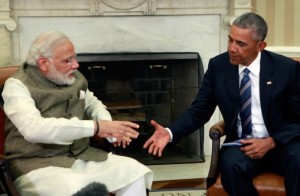
Modi and Obama Shake Hands, but India’s Path to Clean Energy Remains Long
Modi and Obama Shake Hands, but India’s Path to Clean Energy Remains Long
Solar and nuclear power both face economic and political obstacles to rapid build-out.
Indian prime minister Narendra Modi and U.S. president Barack Obama this week reached agreements on energy and climate change that include $60 million in seed financing for renewable-energy and microgrid projects in India; support for the construction of six new nuclear reactors; an effort to limit the spread of hydrofluorocarbons, greenhouse gases (associated with refrigerants) that are much more potent than carbon dioxide; and a push to ratify the Paris climate accord before the end of 2016.
All those efforts are designed to help India achieve its goal of electrifying the millions of villages and rural households that lack access to energy while limiting the country’s greenhouse-gas emissions (see “India’s Energy Crisis”). Modi has made energy access and climate change central to his policies since taking over as head of state two years ago. Among his most ambitious targets are a pledge to increase solar power capacity to 100 gigawatts by 2022 and build enough nuclear plants for this power source to supply one-quarter of the nation’s total by 2050.
Unfortunately, progress on those goals remains slow, and it’s not clear that this week’s announcements will accelerate the process. That bodes ill for both countries, says Ajay Mathur, director general of the Energy and Resources Institute in New Delhi. “Both the U.S. and India have come to understand that for each country, its own clean-energy future is interdependent on the other’s actions,” he says.
Indeed, what happens in India could determine the fate of not only the country’s 1.25 billion people but the rest of the world. India is the third-largest emitter of carbon, behind China and the United States. But its emissions are growing much faster than those of any other country, and they are likely to explode as its economy expands over the next two decades, putting the goal of limiting global warming to 2 °C out of reach.
 Modi and Obama’s handshake deal may not accelerate India’s progress on clean energy.
Modi and Obama’s handshake deal may not accelerate India’s progress on clean energy.
Meeting India’s clean-energy targets will require quickly ramping up solar and nuclear power while dramatically reducing the use of coal; but both those ambitions could prove unrealistic. BP’s 2015 Energy Outlook forecasts that overall energy consumption in India will increase 128 percent by 2035, with fossil fuels supplying 87 percent of the total.
The agreements reached in Washington this week include $40 million in U.S. funding for solar installations and microgrids in rural villages, and another $20 million to finance renewable-energy projects, mostly solar plants. That’s small change relative to the scale of India’s energy challenge, but White House officials say the U.S. financing could help unleash billions in private funding.
Foreign developers have flocked to India in recent years to take advantage of the solar boom unfolding with the government’s support, but it’s not clear that the projects they are signing deals on will ever be profitable (see “In India’s Hot Summer, the Solar Market Overheats”). Bids for building solar power in India have fallen below 5 rupees (7.5 U.S. cents) per kilowatt-hour, but India’s Central Electricity Regulatory Commission says 7.04 rupees per kilowatt-hour is the threshold of viability for solar photovoltaic projects. Adding to the risks for solar project developers is that many of the Indian utilities signing agreements to buy solar power are “financially weak and have weak grids to boot,” says Rahul Tongia, a research fellow with Brookings India in New Delhi.
So far none of this has slowed solar’s expansion. According to Kolkata-based Mercom Capital Group, 2.2 gigawatts of solar capacity have been installed so far in 2016, already eclipsing total installations in 2015. The firm expects solar additions to surpass five gigawatts in 2016. That’s more than double last year’s total, but still well below the rate needed to reach 100 gigawatts by 2022. India now has around 7.5 gigawatts of solar capacity nationwide.
On nuclear power, the two leaders set a deadline of June 2017 to finalize negotiations on a deal for Westinghouse, a unit of the Japanese industrial giant Toshiba, to build six advanced reactors in India by 2030. Several barriers to that deal remain, however, including the fact that India has never signed the international Nuclear Non-Proliferation Treaty, leading many to oppose U.S.-India nuclear coöperation. What’s more, local opposition to nuclear plants remains strong in India: already, the Westinghouse complex has been forced to abandon its original site, planned for Modi’s home state of Gujarat.
Ultimately, simple economics could limit the expansion of nuclear power, says Lydia Powell, director of the Centre for Resources Management at the Observer Research Foundation in New Delhi. India’s coal plants, which supply more than 70 percent of the country’s electricity, can produce power for as little as 2.5 rupees per kilowatt-hour. “I cannot see modern Westinghouse reactors competing with [fossil-fuel plants] without some sort of government crutch,” she says.

Leave a Reply